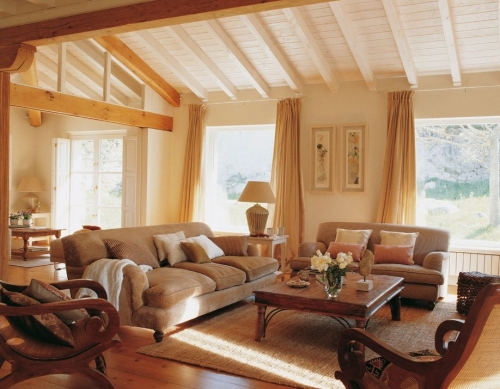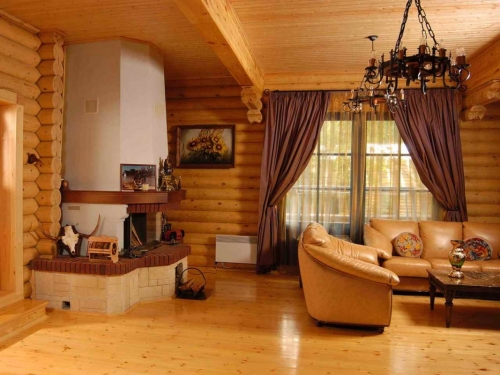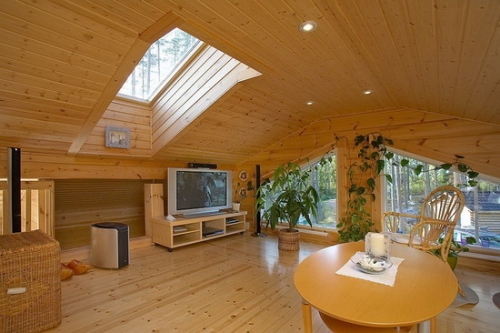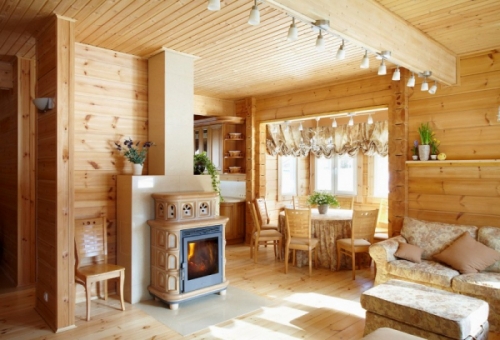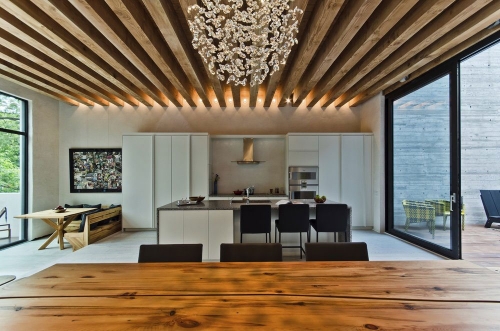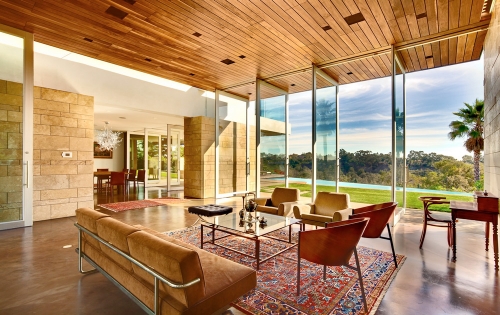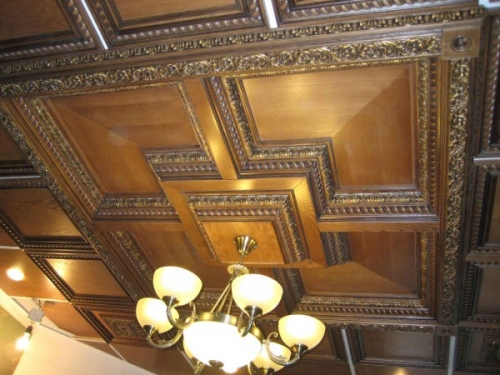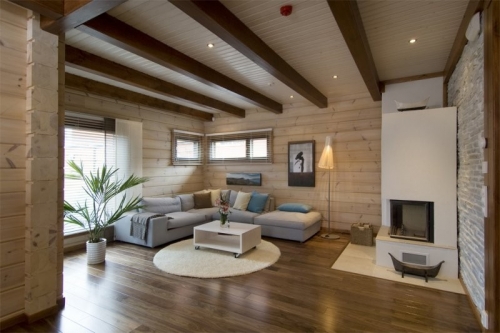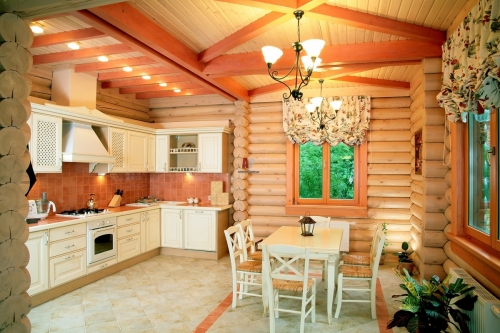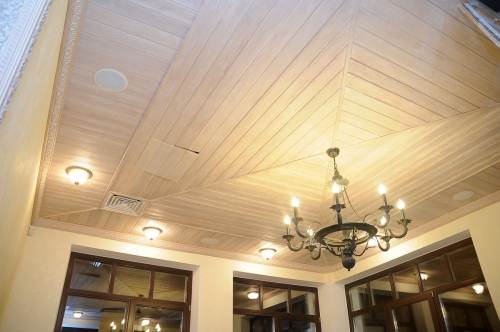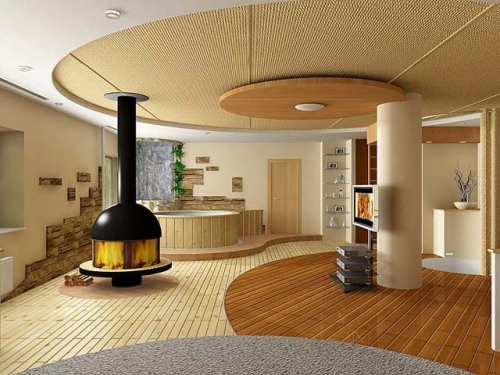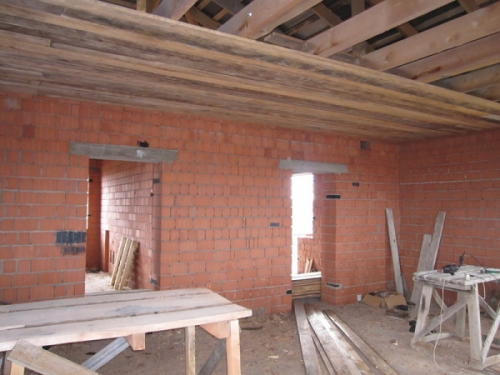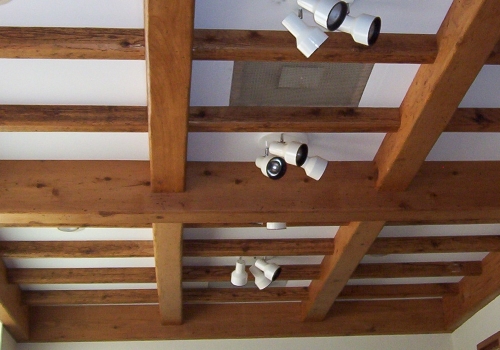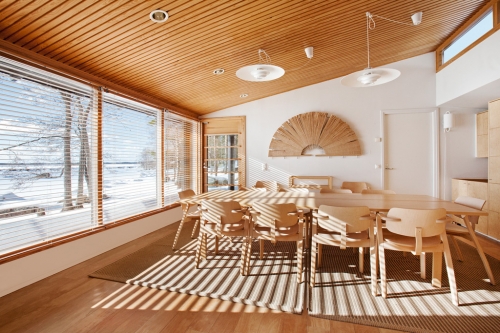Wooden windows are quite common in most residential buildings. This is explained ...
|
|
The most original solution for creating a non -repeated atmosphere in your house is ... |
Any person dreams of living in a private house with a personal plot, and very often ... |
DIY wood ceiling

The demand for ceilings from wood has repeatedly experienced ups and falls, and if in Soviet times they were installed only in the hallways, today they become the perfect addition of any room. The choice of a stylistic solution, within which wooden ceilings will be relevant, also does not cause difficulties, they will fit not only into classical, but also in modern interiors. A rich selection of finishing materials, their extensive price range, as well as the use of innovative repair technologies allows you to install ceilings made of natural wood not only in suburban cottages in which wooden floors are present, but also in apartments with high ceilings. The high popularity of wooden ceilings is easily explained, because it is not for nothing that the tree is considered one of the most suitable finishing materials for residential premises. Boards and panels made of natural wood are environmentally friendly finishing material, which contains synthetic components, such as phenols, antipyrene and formaldehydes. This is due to the conditions for the use of finishing material, implying the absence of atmospheric moisture in the living room, and therefore, the tree does not need protective coatings and synthetic impregnations. Despite the common stereotype that the tree is used only for flooring or walls, in this article we will demonstrate how successful the ceilings can be successful with natural wood.
Content
- Advantages and disadvantages of wooden ceilings
- Varieties of finishing materials from wood: brief description
- Popular varieties of wooden ceilings
- Wooden ceilings design options: draw up correctly
- Installation of a wooden ceiling: step -by -step guide
Advantages and disadvantages of wooden ceilings
Advantages of wooden ceilings:
- Wood is an environmentally friendly material, and the impregnations used for its processing do not contain harmful substances. Thanks to this advantage, it can be used to decorate the ceilings in the nursery;
- A long operational period, during which a decorative ceiling made of wood will retain its original appearance. Provided to comply with the appropriate care, once by mounting the ceiling structure, you do not have to regularly put it in order. An important role in this is played by the use of various mastics, antiseptics, impregnation and painting products;
- In view of low thermal conductivity, the tree acts as an effective heat insulator. In addition, using a tree as a material for finishing the ceilings, you get the ability to install an additional layer of insulation;
- Thanks to the high soundproofing qualities of wood, you can create the necessary acoustics in the room;
- Having carried out the decoration of walls and ceilings with wood, you will create a favorable microclimate in the room and the optimal level of air humidity, which will create comfortable conditions for a person's stay;
- Thanks to the ceiling trimmed with wood, the room acquires a special aesthetics and respectability inherent in natural materials. Wooden ceilings do not need to be stained with varnish enough.
Disadvantages of wooden ceilings:
- Wooden ceilings need additional treatment with antiseptic impregnations that protect wood from mold and prevent the formation of rot. In addition, bugs-girls who destroy it negatively affect the wood;
- Ceilings of dry, surviving wood are considered a risk factor, in connection with which they need additional processing with fire -retardant mixtures;
- The high cost of natural materials is another drawback of wooden ceilings, however, the cost of repairs can be significantly reduced by installing with your own hands.
Wood ceiling photo
Varieties of finishing materials from wood: brief description
The design of the ceiling surface largely depends on the type of finishing materials used. Today, there is no longer a ceiling, the construction market sheathed with a simple board offers an abundance of wood -final materials.
Consider the main varieties and their brief description:
Wooden panels A collective concept, which includes a number of finishing materials, each of which has a certain set of characteristics. Consider them in more detail.
- A lining, which is also called a croach or a trim tested by time, universal finishing material. It is a wooden boards equipped with special grooves on both sides, which provide a tight fit of neighboring elements to each other. The ceilings sheathed with lining are characterized by smoothness, resistance to sharp temperature differences and high sound and heat-insulating characteristics. Usually they are made of certain varieties of wood: oak, beech, pine or linden. In the process of choosing a wood breed, keep in mind that the coniferous in the process of heating is highlighted, and therefore, it is not recommended to use them for decoration of wood ceilings;
Important! The lining made of the core of the tree is difficult to process and often cracks, but has exceptional water -repellent characteristics;
The lining made from the regional parts of the barrel is much easier to process and is practically not subject to the formation of cracks.
The spectrum of using the lining is quite widely used for lining of multi -level ceilings that are designed to decorate space and secrete functional zones.
- A type of lining made in accordance with European standards is eVERYTHING. Unlike the domestic, the Eurolank is distinguished by the principle of surface processing. On the outside, the Euromaterial is carefully polished and saturated with special compounds, a ventilation groove is provided on the back surface, through which moisture is also removed. In addition, the distinguishing feature of the Eurolanka is the exact dimensions, the strict geometry of the shapes and the perfectly flat surface. In this regard, it can be safely argued that the Eurolinka does not need additional processing and can immediately be used to install the ceiling made of wood.
- Ceiling block house It is a wooden panels imitating a convex log surface. It is saturated with antiseptics and anti -pires that reduce the combustibility of the material. Using a block house for installation, you can make wood ceilings, a photo of which will resemble an old log hut folded from whole wood trunks. The block house is considered a fairly solid and high-quality material for the design of the ceiling surface;
- Decorative panels Three -layer material for finishing the ceiling surface. Its layers are glued in factories according to the latest technologies, the basic principles of which are the use of high temperature and pressure. Decorative panels consist of three layers: an expensive facial layer made of valuable wood, and two other layers for which spruce or pine was used. In most cases, they are made to order, taking into account the size of a particular room;
- MDF panelsOf course, they are not related to wood, however, they are perfect for simulating a wooden coating. In addition, in view of their democratic value, they are a popular budget option for repair;
- Wooden beams The finishing material with which you can emphasize the color of the room by focusing on its advantages. If you do not want to install beams made of solid wood massif, but you want to use them as a decorative element, false beams will be optimal for this material. By color, they can be in the tone of a common interior or contrasting shade.
- Facing plates Material made of natural wood, immune to the mud, is practically not relaxed and not cracked. There are samples impregnated with wax, they are immune to moisture, and therefore, are used to skin ceilings in the kitchen or bathroom.
- Wooden wallpaper Environmentally friendly material that creates a cozy natural atmosphere in the house. The use of natural wood for their manufacture is a new, promising step in their manufacture, the essence of which is to combine wooden panels and traditional wallpaper. The unique combinatoric of these materials made it possible to almost endlessly expand the possibilities of their use.
Consider the main features of wooden wallpaper:
- Own wallpapers are one of the varieties of wooden wallpaper, the thickness of which reaches 1.56 mm. For their manufacture, valuable wood is used by gluing veneer on paper wallpaper;
- The wallpaper from traffic jams supplied in rolls or sheets is made from a pressed cork. They are an effective sound insulator, do not absorb extraneous smells and are easy to clean from pollution.
Important! The use of wooden wallpaper is limited to their fire hazard and susceptibility to moisture, and therefore, they are not recommended to use in the kitchen and especially in the bathroom.
- Ceiling tape It is a decorative skirting board made of wood, using which you can emphasize the design of a wooden ceiling and hide the possible flaws of your work.
Unlike fillets made of other materials, wooden have a certain set of advantages, such as unique strength, long -term operational period and natural color.
Two varieties of wooden fillets are distinguished:
- Laminated;
- Openced.
The fillets are mounted using self -tapping screws equipped with decorative plugs, clips or liquid nails.
The wood breed used for the manufacture of fillets is another classification feature. In accordance with it, distinguish:
- Pine tape Soft material, served by machining. This allows you to expand the possibilities of independent decoration of the ceiling surface;
- Lipov fingeluniversal material widely used to decorate premises for various purposes from bedrooms to saunas;
- ALKHOVA taller Durable, light wooden material, which involves staining in any color.
Popular varieties of wooden ceilings
The most popular design of wooden ceilings is the so -called wooden bell ceiling, which got its name due to the features of fastening panels. They seem to be fucked, that is, they are attached from below to the ceiling. In most cases, the bearing ceilings are equipped in houses with wooden floors, but they can be found in residential buildings with concrete ceilings.
Given the materials used, which were described above, the following types of wood ceilings are distinguished:
- Bearing ceiling from the lining and EurolinkaA common way to arrange a ceiling surface, loved by most masters due to the simplicity of installation. To equip such a ceiling, you need a boon from various wood: pine, oak, linden and others. The lining is mounted to the frame on the ceiling ceiling, and the docking is the type of spike;
- Panel In their constructive features, it is similar to the previous option, but not boards are attached to the frame, but whole ceiling panels. Ceilings equipped with panel type consist of wooden multi -layer shields, from the outside of the veneer of wood of valuable species;
- A relief bell ceilingAnother variety of bearing ceilings, for the manufacture of which a stab beam is used. To install a relief ceiling, a rectangular wooden workpiece is required, which is split along and attached to the frame with the smooth side. The bars can be fixed in such a way that the natural chips of wood are facing the room. This will not only recreate a unique ceiling pattern, but also diversify the atmosphere of the room with notes of village comfort;
- Kessoni ceilings made of wood A special type of ceiling surface, the assembly of which is carried out using special box modules called caissons. Despite the fact that they are difficult to manufacture, they are the most spectacular option appropriate in rooms decorated in a classic style.
Wooden ceilings design options: draw up correctly
Relief and patterned structures
The most important principle of installation of the original embossed ceiling with patterns is the variety of options for the location of the lining parts, for example, at an angle, a Christmas tree or cage. Thanks to this limitless fantasy field, the master gets the opportunity to create an unusual pattern that will correspond to its taste and imagination.
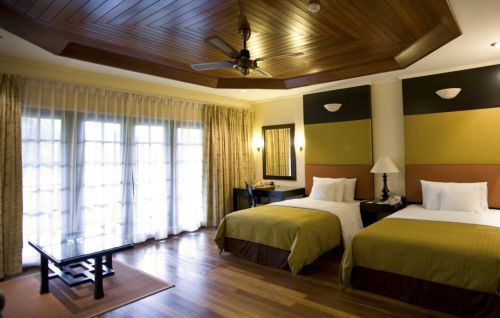
The principle described above lies at the basis of the installation of a rack ceiling made of wood, for the arrangement of which small planks, rails, cutting of wooden boards will be needed. These elements are formed according to the principle of mosaics in complex drawings and ornaments. To facilitate the process of preparing complex ornaments, you can preliminarily draw up a plan of the ceiling structure on paper, and then transfer it to the plane.
Stretch ceiling
Often, masters come to the conclusion that in the process of designing a ceiling of natural wood is not enough and in these cases additional finishing materials have to be used, which will diversify their design. In these cases, masters recommend paying attention to stretch and suspended ceilings made of wood. It is important to remember that stretch ceilings mounted on a wood ceiling are stretching and fixing the canvas.
Consider the basic principles of their installation:
An important stage in the arrangement of the stretch ceiling Installation around the perimeter of the ceiling of the Baget Profile;
If you do not go into details, the next stage implies the heating of the expanded and stretched canvas with a heat gun and its fixing in the corners of the profile after it becomes supple. Cooling, a strong tension of the film occurs, and it turns into an absolutely even ceiling surface;
Important! Remember that the installation of stretch ceilings on the ceiling of wood can be carried out almost immediately, on new wooden ceilings, without waiting for their final drying.
The stretch ceiling can be supplemented with elegant portals and protrusions, various additional elements made of wood and exclusive embossed beams, which will become an integral element in the design of the ceiling made of wood.
Installation of a wooden ceiling: step -by -step guide
Preparation of the base and installation of the frame
- If you set yourself the goal of installing the ceiling from wooden panels or boards, the first thing you need to start, this is the preparation of ceiling ceiling.
- Before mounting the ceiling frame, clean the ceiling ceiling, removing the remaining old finishes;
- In view of the high sensitivity of the wooden ceiling to waterlogging, if necessary, equip the waterproofing layer on top of the floor;
- If the ceiling ceiling is made of wood, it is processed with fire -protection material, which will prevent its destruction by aggressive biological agents and increase its resistance to fire;
- After you cleaned the overlap and prepared it for the further stages of the ceiling arrangement, proceed to the installation of the frame, to which wooden casing will be attached. For this:
- Apply the markup to the ceiling to which the frame will be attached, while the marking step depends on the size of the finishing material used for lining, whether it be a wooden lining or veneered panels;
- For the manufacture of the frame, experts recommend using bars of 30 x 30 mm in size. Before installation, they must be impregnated with olifa or other composition, which will prevent its waterlogging and swelling.
Important! Remember that the bars that make up the frame should be fixed in one plane. If ceiling ceilings are not even enough, in view of which it is not possible, it is necessary to align the frame. To do this, wooden or plastic mounting wedges are knocked under the bars.
- To fasten the bars to the ceiling overlap, use a dowel with a metal sleeve or turbotins. After you fixed the bars of the frame, check its plane again and, if necessary, adjust the screws again.
Ceiling the ceiling with wood
The final stage of installation of a wooden ceiling is the casing of the frame with a wooden lining or veneered panels.
- Material prepared for skin, adjust to the size of your ceiling;
- Attach the panel or board to the frame and using nails intended for hidden fasteners, fix it on the bars. To increase the reliability of the mounting of the panel or lining, clog the nail into the groove not vertically, but at an angle;
- In places on which an increased load is laid, make an additional fastening of the lining with self -tapping screws, while partially lining the hats of self -tapping screws into the wood, and then masking them.
Important! In the process of fastening the panels or lining between neighboring elements, it is important to leave a slight free space, which will allow the material to endlessly transfer temperature deformations without the formation of cracks and swelling.
- The final stage of installing a wooden ceiling impregnation with a protective composition and varnishing. Painting of wooden ceilings is also possible, but for this experts recommend choosing the cheapest material, since the paint in any case will hide the texture of the material, and the joints between neighboring elements do not have to thoroughly putty.

